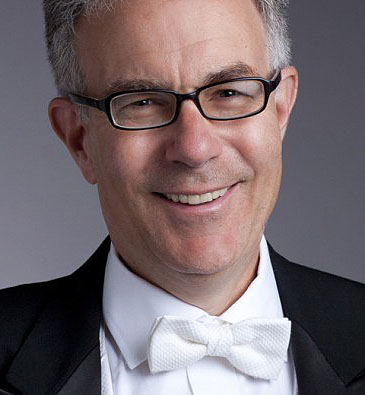
 Each year, there comes a day toward the end of winter when the repertoire and schedule for the next Chicago Symphony season is announced. For those of us in the orchestra, looking through the new schedule is like opening presents on Christmas morning: I am always delighted to see a good number of works that I dearly love. It is especially gratifying to see unjustly neglected repertoire on the schedule, music we don’t play nearly as often as I wish we did. I thought I might share with you some of the repertoire that will rank among my personal highlights for the 2014/15 season.
Each year, there comes a day toward the end of winter when the repertoire and schedule for the next Chicago Symphony season is announced. For those of us in the orchestra, looking through the new schedule is like opening presents on Christmas morning: I am always delighted to see a good number of works that I dearly love. It is especially gratifying to see unjustly neglected repertoire on the schedule, music we don’t play nearly as often as I wish we did. I thought I might share with you some of the repertoire that will rank among my personal highlights for the 2014/15 season.
Messiaen, Turangalîla Symphony, May 21-23, 2015
My sister, who lived in Indonesia many years ago, once told me that the same word in Indonesian means both “truth” and “coincidence.” Days there are grouped in many combinations besides our weeks and months, creating cycles of different lengths. When these cycles align, this coincidence is considered significant, perhaps a bit like how we note when our different patterns of numbered days in a month and days in a week periodically line up to give us a Friday 13th. Similarly, their music is organized in simultaneous cycles; each gamelan musician, for example, plays his own pattern of a different length, and the patterns go in and out of sync in a kaleidoscopic manner. This is my understanding of it at any rate; I am certainly no ethnomusicologist.
Olivier Messiaen was fascinated by music from this part of the world. His inspiration sprang from a profound religious faith bound up in an adoration of nature, which in his view never allows its symmetries to devolve into monotonous regularity. For this reason, he was dissatisfied with the regular rhythms of most Western music, such as the endlessly repeating patterns of strong and weak beats in a march or a waltz. He needed a new way to think about rhythm, and he found it in part by exploring the music of Java and Bali.
“Turangalila” derives from two Sanskrit words that roughly mean “love song” and “hymn of joy.” In his diary, Messiaen described the joy depicted in this work as “superhuman, overflowing, dazzling and abandoned,” which strikes me as exactly right. His long search to arrive at new approaches to rhythm bore astonishing fruit. His pinwheeling kaleidoscopes of rhythmic cycles transcend the 1-2-3, 1-2-3 patterns that would keep us earthbound; they seem to free us from our physical limits and even the laws of physics. In Turangalîla, we fly with a joy that is almost madness, intensely visceral and yet beyond physicality. As an added bonus, the fifth movement has what must be the coolest title in our repertoire: “Joie du Sang des Étoiles” (“Joy of the Blood of the Stars”).
Turangalîla employs a huge orchestra with a massive percussion battery, a fiendishly intricate piano part, and the ondes Martenot, a bizarre primitive electronic instrument contributing an unforgettable extraterrestrial yet passionate wail to the proceedings. The sound of the orchestra that Messiaen achieves somehow manages to be at once barbaric, tender, cataclysmic and erotic.
Bruckner, Symphony No. 8, April 24-26
The conventional wisdom has it that it is a brutal chore to play Bruckner’s string parts, particularly the inner voices that are entrusted to the second violins and my instrument, the violas. Our parts can indeed be quite strenuous, in part because Bruckner loved the technique known as tremolo, an Italian cognate for “tremble,” in which we move our bows very quickly back and forth to sustain a single pitch.
A couple of points must be made. First, Bruckner was a virtuoso organist; he employed “tremolo” quite effectively to create an organ-like texture in his sound. When the note is sustained with tremolo, there is no beginning or end to it, as there can be when we come to the end of a single bow stroke. It creates, as an organ can, an unbroken sound, with no gaps in the musical line.
Second, all the tremolo notwithstanding, Bruckner actually writes wonderful viola parts. As an organist, he developed a mastery of counterpoint, the science of combining different melodies so that they harmonize with each other. Consequently, the violas rarely have a prosaic “accompaniment” to play; we actually have our own melody. To use Glenn Gould’s wonderful formulation, every note we play has a past and a future; it derives logically from what came before it and convincingly leads on to what follows. Our parts flow just as beautifully as the more prominent melodies and are intensely gratifying to play.
The last movement of this symphony begins with a brutal martial rhythm underlining brilliant brass fanfares. Sir Georg Solti once remarked at a rehearsal that Bruckner was depicting Kaiser Wilhelm’s cavalry, which made a terrifying impression upon him when he saw them. To me, it is as if Bruckner somehow glimpsed into the future, foreseeing at the end of the 19th century that the rampant power of German militarism would tear his world asunder in the century to come. Just before the final heroic peroration there is a heartbreakingly tragic passage that strikes me as an elegy for this world about to be lost. The final gesture is Bruckner at the top of his game. Miraculously, he contrives to have the principal themes of all four movements playing simultaneously, harmonizing perfectly with one another. I have always wondered whether in this passage he was striving to elevate his art so that it might prevail somehow over the looming tragedy he sensed was imminent.
Beyond the Score, Brahms’ Symphony No. 3, March 27, 29
One of the wonderful innovations in recent years at the CSO has been Gerard McBurney’s extraordinary multimedia Beyond the Score series. No matter how well I know the piece Beyond the Score is addressing, I always feel by the end of the program as if a painting that I had previously only known from a black-and-white photograph is finally depicted in its real colors. Gerard, with encyclopedic research, an unerring eye for the perfect telling detail and a wonderful sense of drama, creates scenes that allow us to live in the world from which our most beloved masterpieces sprung.
There is not a trace of the didactic in these programs. While at times the orchestra plays excerpts to illustrate aspects of the music, these are nothing like the “examples” you might encounter in a music history lecture. Gerard finds a way to tell the music’s story seamlessly, with the orchestra’s playing flowing into the actors’ depictions and the visual elements on the screen behind us. I am always gratified by the audience’s reaction when we perform the entire work after intermission; we can sense a heightened intensity in the listening.
It may seem strange to mention a Brahms Symphony in the context of underappreciated masterpieces, but the Third is played far less than the others. There is an absurdly prosaic reason for this, in my view. It ends softly; in fact, it disappears rather than ends. Consequently, conductors almost always opt for one of the other Brahms symphonies, which all offer a big finish and elicit a more gratifying burst of applause after the last note.
It is a pity that we play it so rarely, because I consider it the most beautiful of the Brahms symphonies. The first movement is both turbulent and joyous, with moments of tender calm. The two middle movements rank among Brahms’ most heartfelt and melodious, and the last movement starts with seething tumult and ends with a blessed serenity. It never fails to leave me in an altered and immeasurably improved state.
There will be two other Beyond the Score entries next season, one illuminating the music of Boulez (Nov. 14 and 16) and one dedicated to Ravel (June 5 and 7, 2015). If you have never experienced Mr. McBurney’s handiwork, I cannot urge you strongly enough to venture to one of these performances. But then, there are countless other concerts that I have not mentioned that will inspire you and make your world a far richer and more beautiful place. We will do all we can from the stage to convey our love for the music; we just need you to come and share it. I look forward to seeing you soon.
Composer-arranger-instructor Max Raimi has been a member of the CSO’s viola section since 1984.